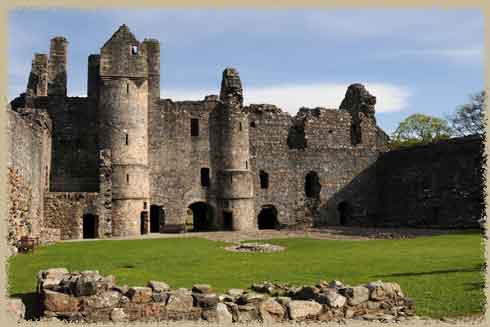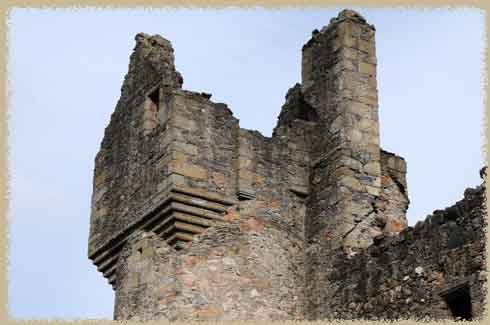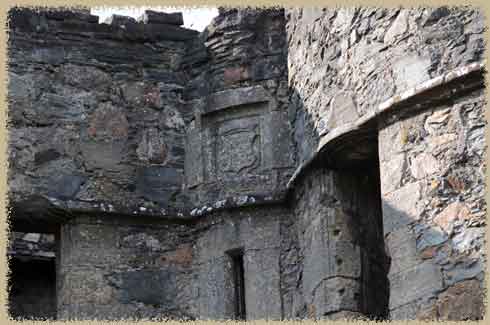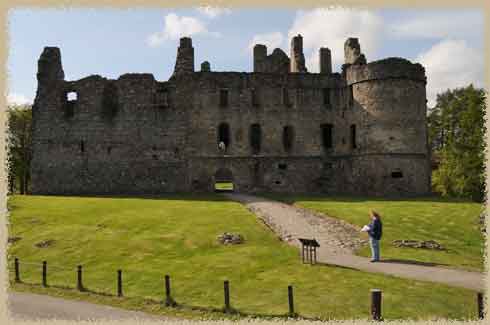Balvenie Castle
This castle is more like a big manor house than the ruins we've been looking at lately, and it's well worth the time to visit. We sailed in at the end of the day, and had the place to ourselves. Balvenie is a lovely castle.

the two stair towers from the inner courtyard
13th century Courtyard Castle
Driving up to Balevnie feels ore like visiting a country house, than approaching a fortified castle. Wihle the original structures here were defensive, as castle was updated and expanded, it was remade into a comfortable house surrounding a large courtyard.
The castle really has three separate sets of remains: a 13th century curtain wall, a 15th century courtyard castle, and a 16th century not residence. Walking around the courtyard, it is easy to see the three difference phases of building.
The curtain wall, which is mostly intact, dates from the 13th century, and the main part of the ruin is a 16th century L-plan tower in one corner.A large round tower stands next to the entryway. The older buildings include a large vaulted cellar and a great hall. The castle is very large, a 33m x 40m courtyard enclosed by 2m-thick walls, with the main buildings filling two sides of the courtyard. The oldest part of the caste is the 13th century curtain wall and ditch. The base of the wall has battered plinths and a number of unusual gunports. It is a rare example of the fortification style of the 13th century.
The tower house part of the ruin is four storys, and has two round stair towers, one tipped with a square room. THere are three barrel-vaulted cellars in the block, and a number of chambers on the first floor over the entrance. THe top floors are ruined, but there are enough details left to piece together a very comfortable living space.

the square caphouse on top of the 16th century stair tower
There may have been round towers on each corner, and more stone walling in the surroudnign ditch from the earlier castle, but these were destroyed or removed in subsequent rebuidling. There are some blocked openings in the remaining buidling that would have allowed access to and from the missing tower. The restoration included most of the building ranges inside the wall that existed in the 15th century, and added the large tower house.
The southwest block was probably never more than two storiies and used as living space or an extended hall. The current third story was a much later addition. There is a very ruined hall range in the northwest corner, with extremely thick walls that matched the thickness of the exterior curtain wall -- surprising, but this matches the extremely thick walls of the hall in the southeast as well. These pieces date from the 13th century and were incorporated into later buildings.
The existing round tower and connected buildings are all much later and have always been meant as a comfortable house, not a fortification, and are often referred to as "The Atholl Lodgings". There are large, decorative windows and string molding around the round towr and facade of the building, and another bit of decoration at attic level. The fact that the two main-floor rooms are entered directly from the courtyard is another hint that the building here was not meant to be a defensible castle, but a stately home.

the string course and coats-of-arms spaces on the facade
Then entry to the castle is thorugh a long gateway arch in the facade, which has the remains of a metal yett (gate) and decorative moldings around the arches. There are a number of empty spaces where stone plaques for dates/names owuld have been displayed, although they are no longer in place.
Ownership
The original castle here (called Mortlach Castle) was restored by the Comyn family in 1304, The new castle was destroyed by Robert the Bruce in 1308 (possibly in retribution for hosting the English king Edwrad I here a few years earlier).

the 16th c house is seamlessly melded to the older 13th and 15th c. pieces
The Douglases took ownership of the ruined castle and rebuilt it--but it was taken from the family by James II in 1455, when the kiing grtanted it to John Stewart, the 1st Earl of Atholl. Upon the death of the 9th Earl, the lands were surrendered to the control of James VI in 1610.(Balvenie also rates a 'Mary Queen of Scots slept here' sign: she stayed here in 1562)
After passing through a few other hands, very briefly, Balvenie was sold to Robert Innes in 1614. He and his son were both prosectured for minor crimes, and fell into debt, were forced to defend the castle against attack from their neighbors, and through the first several decades of the 17th century, were in various positions of power in local government. It's likely they were both killed in 1634.


